![]()
![]()
![]()
Use LEFT and RIGHT arrow keys to navigate between flashcards;
Use UP and DOWN arrow keys to flip the card;
H to show hint;
A reads text to speech;
122 Cards in this Set
- Front
- Back
|
What is the equation for Kinetic Energy? |
0.5 x mass x (speed) ^2 |
|
|
What is the equation for Gravitational Potential Energy (GPE)? |
mass x gravitational field strength x height |
|
|
What is the equation for the equation for Elastic Potential Energy? |
0.5 x spring constant x (extension)^2 |
|
|
What is the equation for Specific Heat Capacity? |
Change in Thermal Energy / (Mass x Temperature Change) |
|
|
What is the Required Practical associated with Energy Stores and Transfers? |
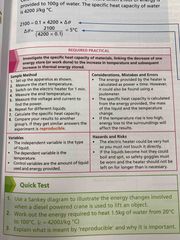
Back (Definition) |
|
|
EXAMPLE OF SANKEY DIAGRAM |
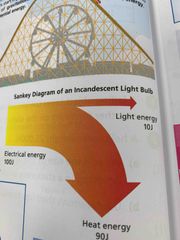
Back (Definition) |
|
|
In a system, what increases energy stored? |
Doing work on a system. |
|
|
What is a system? |
An object or group of objects. |
|
|
What is the Required Practical associated with Energy Stores and Transfers? |
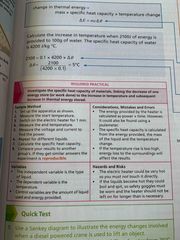
Back (Definition) |
|
|
What happens to Energy in a Closed System? |
The Total Energy never changes, it can only be transferred from one store to another. |
|
|
How may one reduce Unwanted Energy Transfers? |
•Lubrication - Reduces Friction •Tightening any loose parts - prevents unwanted vibration Sound Energy. •Thermal Insulation - Reduce Heat Loss. |
|
|
What is the Required Practical associated with Energy Transfers and Resources? |
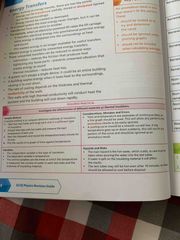
Back (Definition) |
|
|
What is Renewable Energy? |
Energy that can be replenished. |
|
|
What is Non-Renewable Energy? |
Energy that will eventually run out. |
|
|
GLOBAL ENERGY RESOURCES |

Back (Definition) |
|
|
What is the Required Practical associated with Particle Models of Matter? |
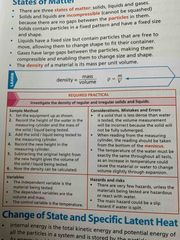
Back (Definition) |
|
|
What is the equation for Density? |
Mass / Volume |
|
|
What is Internal Energy? |
The total Kinetic and GP Energy of all the particles in a system. |
|
|
What happens to a System if more Energy is added? |
The Temperature increases. |
|
|
What is the equation for Energy Required for a Change of State? |
Mass x Specific Latent Heat |
|
|
What is Latent Heat of Fusion? |
The Energy Required for a substance to change from Solid to Liquid. |
|
|
What is the Latent Heat of Vaporisation? |
The Energy needed for a substance to change from Liquid to Gas. |
|
|
What is the equation for Constant (particles)? |
Pressure x Volume |
|
|
Particle Motion & Pressure in Gases |

Back (Definition) |
|
|
CIRCUIT SYMBOLS |
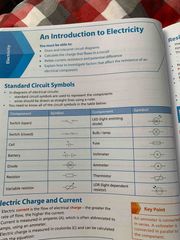
Back (Definition) |
|
|
What is Current? |
The flow of Electrical Charge. |
|
|
What is the equation for Charge? |
Current x Time |
|
|
What is Resistance? |
How much a component resists the flow of charge. |
|
|
What happens as Resistance increases? |
The Current decreases. |
|
|
What happens if the Voltage increases? |
The Current increases. |
|
|
What happens if the Voltage increases? |
The Current increases. |
|
|
What is the equation for Voltage? |
Current x Resistance |
|
|
What if the Required Practical associated with Electricity? |
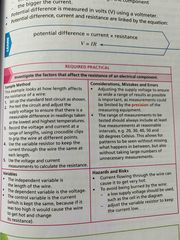
Back (Definition) |
|
|
What is the Required Practical associated with Resistors? |
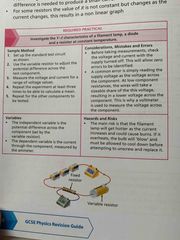
Back (Definition) |
|
|
RESISTORS |
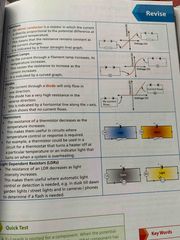
Back (Definition) |
|
|
SERIES AND PARALLEL CIRCUITS |
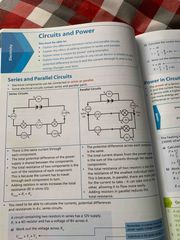
Back (Definition) |
|
|
What is the equation for Power? |
(Voltage x Current) / ((Current)^2 x Resistance) |
|
|
What are the properties of Direct Current? |
•The Voltage that is always positive or always negative. •The Current direction is constant. •Is supplied by Cells/Batteries. |
|
|
What are the properties of Direct Current? |
•The Voltage that is always positive or always negative. •The Current direction is constant. •Is supplied by Cells/Batteries. |
|
|
What are the properties of Alternating Current? |
•Has an alternating Voltage from positive to negative). •The Current direction alternates. •Type of Current used in Mains Electricity. |
|
|
What are the properties of Direct Current? |
•The Voltage that is always positive or always negative. •The Current direction is constant. •Is supplied by Cells/Batteries. |
|
|
What are the properties of Alternating Current? |
•Has an alternating Voltage from positive to negative). •The Current direction alternates. •Type of Current used in Mains Electricity. |
|
|
What are the three wires within Mains supply? |
•Live Wire (Brown) - 230V •Neutral Wire (Blue) - Close to/At 0V •Earth Wire (Green & Yellow) - 0V |
|
|
What is the equation for Power? |
(Energy Transferred / Time) OR (Work Done / Time) |
|
|
What is the equation for Efficiency? |
(Useful Energy Transferred/Total Energy Transferred) OR (Useful Power Output/Total Power Input) |
|
|
What is the equation for Energy Transferred? |
(Power x Time) OR (Charge Flow x Voltage) |
|
|
DIAGRAM OF THE NATIONAL GRID |
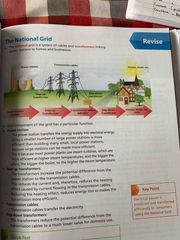
|
|
|
What is Conventional Current? |
When Charges flow from positive and negative. |
|
|
What is the equation describing Ohms Law? |
Voltage = Current x Resistance |
|
|
What happens to the Current and Voltage in a Series Circuit? |
The Current is shared & the Voltage is split. |
|
|
What happens to the Voltage and the Current in a Parallel Circuit? |
The Current is split and the Voltage is shared. |
|
|
What happens when insulating materials rub against each other? |
They can become Electrically Charged. |
|
|
What is an Isolated Object? |
An object that has no Conducting Path to Earth. |
|
|
What are the properties of Electrostatic Forces? |
•They’re Non-Contact Forces. •If they are brought near a Charged Object, it can attract it. •When both object carry the same Charge, they will repel. •When both objects carry opposite Charges, they will attract. |
|
|
What is the radius of an Atom? |
1 x 10^-10 metres |
|
|
How does an Atom become a Positive Ion? |
It’s loses an outer Electron. |
|
|
How does an Atom become a Negative Ion? |
If it gains an Electron. |
|
|
How does an Atom become a Positive Ion? |
It’s loses an outer Electron. |
|
|
How does an Atom become a Negative Ion? |
If it gains an Electron. |
|
|
What are Isotopes? |
Atoms of the same Element that have different numbers of Neutrons. |
|
|
Summarise the Plum Pudding Model. |
It was discovered when JJ Thompson discovered the Electron in 1897. It depicts that the Atom is a ball of Positive Charge with Electrons embedded in it. |
|
|
What is the Required Practical associated with the Particle Model of Matter? |
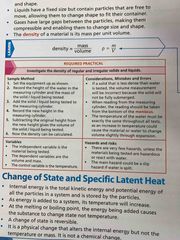
Back (Definition) |
|
|
What is the equation for Density? |
Mass / Volume |
|
|
What is Internal Energy? |
The total Kinetic Energy and Potential Energy of all the Particles in a System. |
|
|
What happens to the Temperature in a System when the amount of Energy is increased? |
It will increase. |
|
|
What is the equation for Energy for a Change of State? |
Mass x Specific Latent Heat |
|
|
What is the Latent Heat of Fusion? |
The Energy needed for a substance to change from Solid to Liquid. |
|
|
What is the Latent Heat of Vaporisation? |
The Energy needed for a substance to change from Liquid to Gas? |
|
|
What is the equation for Energy for a Change of State? |
Mass x Specific Latent Heat |
|
|
What is the Latent Heat of Fusion? |
The Energy needed for a substance to change from Solid to Liquid. |
|
|
What is the Latent Heat of Vaporisation? |
The Energy needed for a substance to change from Liquid to Gas? |
|
|
What is the equation that links Pressure, Volume & Constant? |
Pressure x Volume = Constant |
|
|
What is the equation for Energy for a Change of State? |
Mass x Specific Latent Heat |
|
|
What is the Latent Heat of Fusion? |
The Energy needed for a substance to change from Solid to Liquid. |
|
|
What is the Latent Heat of Vaporisation? |
The Energy needed for a substance to change from Liquid to Gas? |
|
|
What is the equation that links Pressure, Volume & Constant? |
Pressure x Volume = Constant |
|
|
What happens when Work is done on Gas? |
It increases the Internal Energy of the Gas, and can cause an increase in temperature. |
|
|
What is the Plum Pudding Model? |
The theory in which Atoms were a ball of Positive Charge with Electrons embedded in it. |
|
|
What is the Alpha Particle Scattering Experiment and what did it lead to? |
Alpha Particles were fired at thin gold foil. Some were reflected back so they must have been Repelled by the same Charge that the Alpha Particles carried. The mass of the Atom was concentrated in a central Nucleus (positively charged). The Electrons surrounded this. |
|
|
Who was Neils Bohr? |
A Danish Physicist that adapted the Nuclear Model of the Atom by suggesting Electrons orbit the Nucleus. |
|
|
What did James Chadwick do? |
He carried out a number of Experiments that provided evidence that the Neutron existed within the Nucleus. This lead to the structure of the Atom being changed/developed. |
|
|
What is the Activity of a Radioactive Source measured in? |
Becquerels (Bq). |
|
|
What is Count Rate? |
The number of Decays recorded per second. |
|
|
What are the Three main types of Nuclear Radiation? |
•Alpha •Beta •Gamma |
|
|
What are the Components of Alpha Radiation? |
•Two Neutrons and Two Protons. •Alpha Radiation is ejected from the Nucleus. |
|
|
What are the Components of Beta Radiation? |
•A high-speed Electron. •Ejected from the Nucleus as a Neutron, turns into a Proton. |
|
|
What are the Components of Gamma Radiation? |
•Electromagnetic Radiation. •Emitted from the Nucleus. |
|
|
What are the Hazards involved with Alpha Radiation? |
It’s highly likely to be absorbed and cause damage if passing through living Cells. |
|
|
What are the Hazards involved with Beta Radiation? |
•Likely to cause damage if absorbed by Living Cells. •Can penetrate the body to inner Organs. |
|
|
What are the Hazards associated with Gamma Radiation? |
Likely to pass through living Cells without being absorbed and causing Ionisation. |
|
|
What is Radioactive Contamination? |
The unwanted presence of materials containing Radioactive Atoms on other materials. |
|
|
What is Irradiation? |
The process of exposing an object to Nuclear Radiation. It can be deliberate or accidental. It does not cause the object to become Radioactive. |
|
|
What are the Components of Alpha Radiation? |
•Two Neutrons and Two Protons. •Alpha Radiation is ejected from the Nucleus. |
|
|
What are the Components of Beta Radiation? |
•A high-speed Electron. •Ejected from the Nucleus as a Neutron, turns into a Proton. |
|
|
What are the Components of Gamma Radiation? |
•Electromagnetic Radiation. •Emitted from the Nucleus. |
|
|
What are the Hazards involved with Alpha Radiation? |
It’s highly likely to be absorbed and cause damage if passing through living Cells. |
|
|
What are the Hazards involved with Beta Radiation? |
•Likely to cause damage if absorbed by Living Cells. •Can penetrate the body to inner Organs. |
|
|
What are the Hazards associated with Gamma Radiation? |
Likely to pass through living Cells without being absorbed and causing Ionisation. |
|
|
What is Radioactive Contamination? |
The unwanted presence of materials containing Radioactive Atoms on other materials. |
|
|
What is Irradiation? |
The process of exposing an object to Nuclear Radiation. It can be deliberate or accidental. It does not cause the object to become Radioactive. |
|
|
How can you protect against Unwanted Radiation? |
•Using sources of the lowest possible Activity for the shortest amount of time possible. •Wearing appropriate protective clothing such as a Lead Apron. •Not handling with bare hands. |
|
|
What is the Half-Life of a Radioactive Isotope? |
The average time it takes for Half of the Nuclei to Decay. (The time it takes for the Count Rate to fall by 50%). |
|
|
What are the properties of an Isotope with a short Half-Life? |
•Very Unstable - Emits Radiation very quickly, so exposure can be hazardous. •Do not remain Radioactive for long. |
|
|
What are the properties of Isotopes with Long Half-Lives? |
•More Stable - remain Radioactive for long periods of time. •Emit Radiation Slowly - Exposure to substance is less hazardous. |
|
|
List some uses of Nuclear Radiation. |
•Smoke Detectors. •Medical Tracers. •Treatment of Tumours. |
|
|
How is Nuclear Radiation used in Medical Tracers? |
A Radioactive Isotope is ingested or injected into the body. As it travels around the body, it can be detected on the outside. |
|
|
How can you monitor Kidney Function with Nuclear Radiation? |
An Isotope that will pass through the Kidneys is used. If it builds up in one Kidney, it could indicate that it is not working efficiently. |
|
|
How can Nuclear Radiation be used to look for damage or blockages in the Intestines? |
If there’s a blockage, then Radioactivity Levels cannot be detected after the blockage. If they are damaged, the Radioactive source can be seen to pass out of the Intestines in other areas of the body. |
|
|
How can Nuclear Radiation be used for the Treatment of Tumours? |
A Tumour in the Thyroid Gland could be treated with Radioactive Iodine, which gathers in the Gland and destroys nearby Cells. A focussed beam of Gamma Rays can be used to destroy some Tumours. |
|
|
What properties would one have to consider when choosing an Isotope for a specific job? |
•Half-Life. •Activity. •Type of Radiation. |
|
|
Why does a Gamma source of Radiation make the best Tracer? |
They can penetrate the Body and be detected on the outside of the Body. They are the Least Ionising. |
|
|
What is Background Radiation? |
Radiation that is around us all the time. |
|
|
What does the level of Background Radiation depend on? |
•Location - some areas have higher amounts of Natural Radiation. •Occupation - in some jobs you are more exposed to Radiation. |
|
|
SOURCES OF BACKGROUND RADIATION |
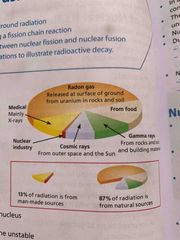
Back (Definition) |
|
|
What is Nuclear Fission? |
The splitting of large a unstable Nucleus. |
|
|
What happens during Nuclear Fission? |
Will not occur (normally) by itself, Nucleus must absorb Neutron first. •The Nucleus splits into two smaller Nuclei, of roughly equal size. •The Nucleus emits two or three smaller Neutrons, Gamma Rays and Energy. All of the Products have Kinetic Energy. |
|
|
How is a Chain Reaction caused in Nuclear Fission? |
When the Neutrons are emitted, they can be absorbed by another large unstable Nuclei. |
|
|
What is Nuclear Fusion? |
The joining of small Nuclei. |
|
|
What happens in Nuclear Fusion? |
Two light Nuclei join together to form a heavier Nucleus. Some of the Mass is converted into energy and some of this may be emitted as Radiation. |
|
|
Why does Nuclear Fusion require high Temperatures and Pressures? |
•To overcome the Electrostatic Repulsion. •To bring the Positive Nuclei close enough together for Fusion to occur. |
|
|
What happens to the Mass & Atomic Number after Alpha Decay? |
•The Mass Number is reduced by 4. •The Atomic Number is reduced by 2. |
|
|
What happens to the Mass & Atomic Number after Beta Decay? |
•The Mass Number doesn’t change. •The Atomic Number is increased by 1. |

